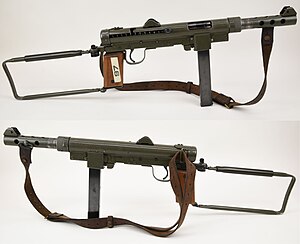| Kulsprutepistol m/45 (Kpist m/45) | |
|---|---|
 Carl Gustaf m/45B | |
| Type | Submachine gun |
| Place of origin | Sweden |
| Service history | |
| In service | 1945–present |
| Used by | See Users |
| Wars | |
| Production history | |
| Designer | Gunnar Johansson |
| Designed | 1944 |
| Manufacturer |
|
| Produced |
|
| No. built | approx. 300,000 |
| Variants | m/45, m/45B, m/45C, m/45BE, m/45BET, m/45S, Port Said, Akaba, US Navy modification (no official designation) with suppressor. |
| Specifications | |
| Mass | 7.38 lbs (3.35 kg) without magazine |
| Length | 21.65/31.81 in (550/808 mm) |
| Barrel length | 8.34 in (212 mm) |
| Cartridge | 9×19mm Parabellum (Known as 9×19mm m/39B in Sweden) |
| Action | Blowback, Simple (straight) |
| Rate of fire | 600 rounds/min |
| Muzzle velocity | 1395 ft/s (425 m/s) |
| Effective firing range | ~273 yards (250 m) |
| Feed system | 36-round box magazine |
The Kulsprutepistol m/45 (Kpist m/45), also known as the Carl Gustaf M/45 and the Swedish K SMG, is a 9×19mm Swedish submachine gun (SMG) designed by Gunnar Johansson, adopted in 1945 (hence the m/45 designation), and manufactured at the Carl Gustafs Stads Gevärsfaktori in Eskilstuna, Sweden. The m/45 was the standard submachine gun of the Swedish Army from 1945 to 1965. It was gradually replaced in Swedish service by updated Automatkarbin 4 battle rifles and Automatkarbin 5 assault rifles. The last official user of the m/45, the Swedish Home Guard (Hemvärnet), retired it from service in April 2007.[4]
The m/45 SMG was developed in 1944–45, with a design borrowing from and also improving on many design elements of earlier submachine guns. The sheet metal stamping techniques used in making the German MP 40, the British Sten, and the Soviet PPSh-41 and PPS-43 were studied in detail.[citation needed] Two designs were tested in 1944, one from Carl Gustafs Stads Gevärsfaktori and one from Husqvarna Vapenfabriks and the prototype from Carl Gustafs Stads Gevärsfaktori was chosen for further development. The first production version was adopted in 1945 as the Kpist m/45. The Danish Hovea M/49 SMG, although similar in appearance, is not a version derived from the m/45. The Hovea was a development of the failed test contender (fm44) from Husqvarna.
- ^ Laffin, John (15 June 1982). Arab Armies of the Middle East Wars 1948–73. Men-at-Arms. Vol. 128. Osprey. pp. 31–33. ISBN 978-0-85045-451-2.
- ^ "Afghanistan – Seized Mujahideen weaponry 008.jpg". Wikimedia Commons.
- ^ "En images : Découverte d'un lot d'armes dans la ville de Tombouctou au Mali" [In pictures: Discovery of a batch of weapons in the city of Timbuktu in Mali]. VOA Afrique (in French). 8 September 2016.
- ^ Andersson, Thomas B. (2017). "Kpist m/45 – trotjänare med skral räckvidd" [Kpist m/45 - faithful servant with a narrow range]. Militär historia (in Swedish). No. 10. Bonniers förlag.